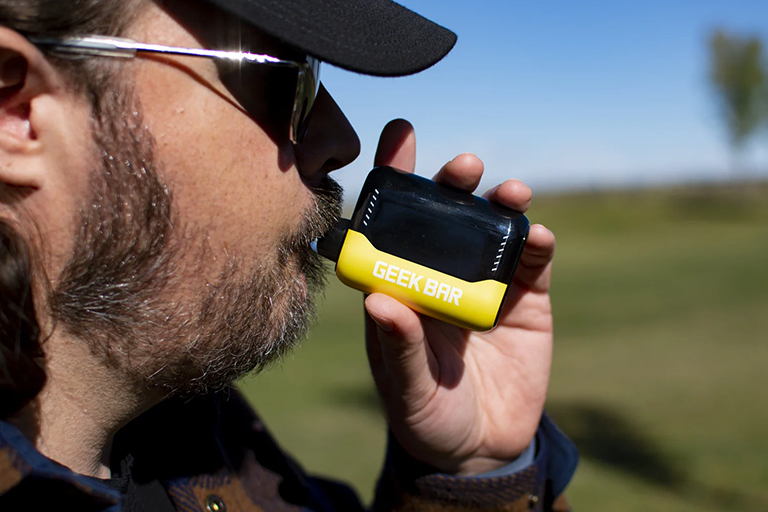Guide
Are Disposable Vapes Safe? A Complete Guide
Disposable vapes have become increasingly popular in recent years due to their convenience, ease of use, and variety of flavors. However, as more people turn to vaping as an alternative to smoking, questions about the safety of disposable vapes have emerged.

The truth is, while disposable vapes are often marketed as a safer alternative to traditional cigarettes, they are not entirely risk-free. Understanding the potential health risks, the ingredients used, and the long-term effects of disposable vapes is crucial for making informed decisions about vaping.
1. How Disposable Vapes Work
Disposable vapes are single-use electronic devices that come pre-filled with e-liquid and a built-in battery. Unlike refillable vapes, disposable vapes are designed to be discarded once the battery or e-liquid runs out.
You also like: Disposable Vape vs Refillable Vape: Which One Is Right for You?
Components of a Disposable Vape:
- Battery: Typically ranges from 280mAh to 5000mAh.
- Heating Element (Coil): A metal coil (often made from kanthal or stainless steel) heats the e-liquid to produce vapor.
- E-Liquid: Contains a mixture of propylene glycol (PG), vegetable glycerin (VG), nicotine, and flavoring agents.
- Wicking Material: Usually cotton, which absorbs the e-liquid and delivers it to the coil.
- Airflow System: Allows air to pass through the device, triggering the heating element.
- Mouthpiece: Where the user inhales the vapor.
When a user inhales through the mouthpiece, the airflow sensor activates the battery, which heats the coil. The heated coil then vaporizes the e-liquid, producing inhalable vapor.
2. What Ingredients Are Used in Disposable Vapes
The ingredients used in disposable vapes are relatively simple, but their effects on health can vary depending on the formulation and concentration.
Main Ingredients in E-Liquids:
Propylene Glycol (PG):
- A colorless and odorless liquid used to create throat hits.
- Generally recognized as safe (GRAS) by the FDA when used in food.
Vegetable Glycerin (VG):
- A thicker, sweeter liquid that produces denser vapor.
- Also considered safe for consumption but may cause irritation in some users.
Nicotine:
- A highly addictive substance derived from tobacco.
- Can cause increased heart rate, elevated blood pressure, and addiction.
Flavoring Agents:
- Natural and artificial flavorings used to create various vape flavors.
- Some flavoring agents may produce harmful byproducts when heated.
Additional Chemicals:
- May include sweeteners, cooling agents (like menthol), and preservatives.
- Certain chemicals like diacetyl and acetoin have been linked to lung issues.
3. Potential Health Risks of Disposable Vapes
While disposable vapes are often promoted as safer than cigarettes, they are not entirely without health risks. The most common concerns include:
3.1. Nicotine Addiction
Nicotine is highly addictive. Even low-nicotine disposable vapes can lead to dependence with regular use. Withdrawal symptoms include irritability, cravings, and difficulty concentrating.
3.2. Respiratory Issues
Heating e-liquid produces aerosolized particles that can irritate the lungs. Over time, this can lead to coughing, shortness of breath, and wheezing.
3.3. Cardiovascular Impact
Nicotine causes blood vessels to constrict and raises heart rate and blood pressure. Prolonged use may increase the risk of heart disease and stroke.
3.4. Chemical Exposure
Heating e-liquid can produce harmful chemicals such as:
- Formaldehyde
- Acrolein
- Acetaldehyde
These chemicals are known to irritate the respiratory tract and may cause long-term health issues.
3.5. Oral and Dental Health Issues
Vaping can lead to dry mouth, gum recession, and tooth decay due to reduced saliva production and exposure to sweeteners in e-liquids.
4. Safety of Nicotine in Disposable Vapes
Nicotine is the most controversial ingredient in disposable vapes. While it’s true that nicotine itself is not a carcinogen, it is a highly addictive substance that impacts brain function and cardiovascular health.
Short-Term Effects of Nicotine:
- Increased heart rate
- Elevated blood pressure
- Dizziness and nausea
Long-Term Effects of Nicotine:
- Increased risk of heart disease
- High blood pressure
- Cognitive impairment, especially in adolescents
The nicotine strength in disposable vapes varies widely, from 0 mg (nicotine-free) to 50 mg (high nicotine concentration). Higher concentrations are often found in salt-based nicotine formulations, which deliver stronger hits and faster absorption.
5. Are Flavored Disposable Vapes Safe?
Disposable vapes are generally considered less harmful than traditional cigarettes but are not entirely safe. They still contain nicotine, which is addictive, and inhaling vapor can expose users to harmful chemicals. Long-term health effects are still being studied, and risks increase with frequent or underage use. For non-smokers, health experts advise against starting any nicotine product, including disposable vapes.
Flavored disposable vapes are popular because they offer a wide range of taste options, from fruity to dessert flavors. However, certain flavoring agents have raised health concerns:
Common Issues with Flavored Vapes:
- Diacetyl: A buttery flavoring linked to bronchiolitis obliterans (popcorn lung).
- Benzaldehyde: A cherry flavoring that can irritate the respiratory tract.
- Sweeteners: Artificial sweeteners may lead to coil buildup and burnt flavors.
Fruit and menthol-based flavors are often viewed as safer than dessert and candy flavors because they are less likely to contain harmful sweeteners and additives.
6. Are Disposable Vapes Safer Than Cigarettes?
While disposable vapes are often marketed as a safer alternative to smoking, this is a complex issue.
Advantages Over Cigarettes:
- Fewer toxic chemicals compared to cigarette smoke.
- No combustion, which reduces exposure to tar and carbon monoxide.
- Less secondhand smoke impact.
Disadvantages Compared to Cigarettes:
- Still delivers nicotine, which is highly addictive.
- Long-term effects of inhaling vaporized chemicals are not fully understood.
- Some chemicals used in flavoring agents are linked to lung disease.
7. Risks of Battery Malfunction and Explosions
Disposable vapes use lithium-ion batteries, which can malfunction or explode if not handled properly.
Common Causes of Battery Issues:
- Overheating due to prolonged use.
- Physical damage to the device.
- Manufacturing defects.
- Exposure to extreme temperatures.
To minimize battery risks, avoid leaving disposable vapes in direct sunlight or near heat sources.
You also like: Types of Disposable Vapes by Battery Type: Pros, Cons, and Buying Guide
8. Environmental Impact of Disposable Vapes
Disposable vapes create environmental concerns due to the combination of plastic, metal, and electronic waste.
Environmental Issues:
- Batteries and electronic components are not biodegradable.
- Improper disposal can lead to battery leakage and soil contamination.
- Plastic waste from disposable vapes contributes to pollution.
Some companies have started introducing recycling programs, but the majority of disposable vapes still end up in landfills.
You also like: How to Dispose of Vapes Properly: A Complete Guide
9. How to Vape Safely and Minimize Risks
- Use lower nicotine strengths to reduce addiction risk.
- Take shorter puffs to avoid overheating the coil.
- Store vapes away from heat and direct sunlight.
- Avoid chain vaping to prevent coil burnout and overheating.
- Choose reputable brands with transparent ingredient lists.
10. Are Disposable Vapes Truly Safe?
Disposable vapes are less harmful than cigarettes but are not entirely risk-free. While they eliminate many of the harmful chemicals produced by combustion, they still expose users to nicotine, flavoring agents, and other potentially harmful substances.
If you choose to use disposable vapes, understanding the ingredients, avoiding harmful flavoring agents, and using lower nicotine strengths can help minimize the risks associated with vaping. Ultimately, disposable vapes should be viewed as a harm reduction tool rather than a completely safe alternative to smoking.





